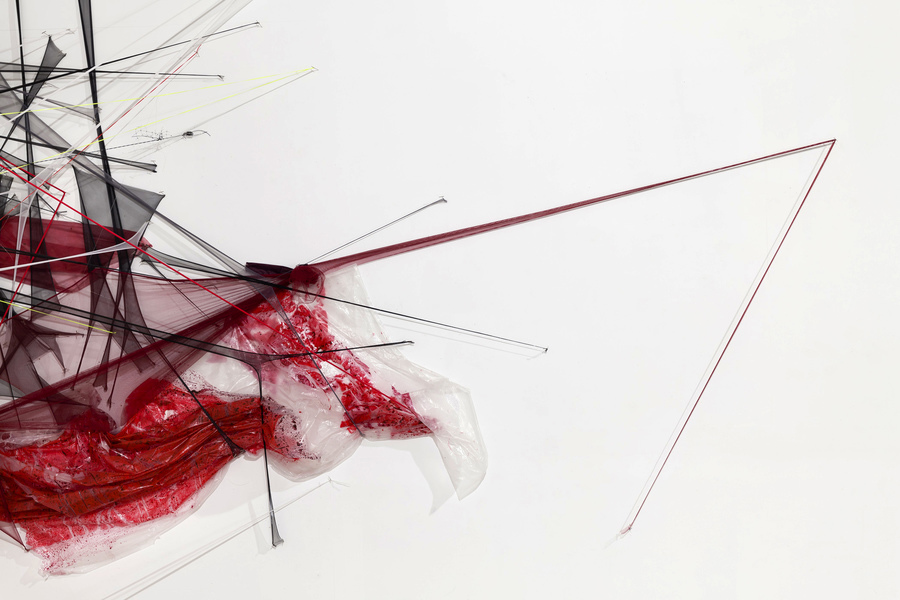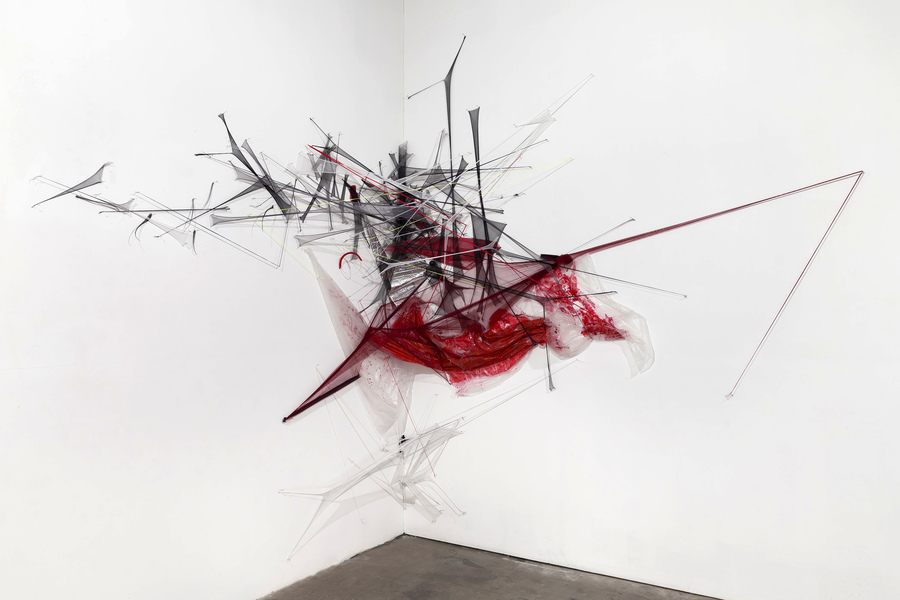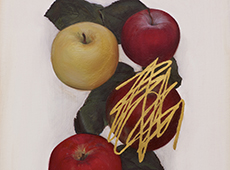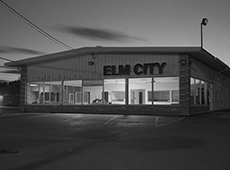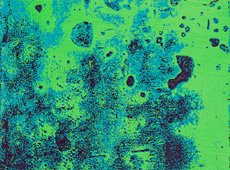I begin thinking about a site-responsive installation in terms of delineating discrete areas of sculptural marks hewing closely to the walls. These zones are constructed with simple synthetic materials—mosquito netting, fishing line, plastic tarps—that give my vocabulary physicality, but don’t weigh it down. Materials that can be manipulated into varied configurations help me navigate and understand the space. Architectural idiosyncrasies and impediments are desirable; they’re both infuriating and valuable grist for the mill. I’m wary of becoming too acquainted with a site before I begin—I need it as a real-time collaborator.
For some time, the two primary aspects of my practice—installation and drawing—were largely independent of each other. In the last few years, I’ve been trying to bring them closer together, both conceptually and materially.
Top: Gelah Penn, detail,
Photos by Etienne Frossard and courtesy Gelah Penn. Click images to enlarge.
I begin thinking about a site-responsive installation in terms of delineating discrete areas of sculptural marks hewing closely to the walls. These zones are constructed with simple synthetic materials—mosquito netting, fishing line, plastic tarps—that give my vocabulary physicality, but don’t weigh it down. Materials that can be manipulated into varied configurations help me navigate and understand the space. Architectural idiosyncrasies and impediments are desirable; they’re both infuriating and valuable grist for the mill. I’m wary of becoming too acquainted with a site before I begin—I need it as a real-time collaborator. Over-familiarity can breed tedium or vexation. Although I make some preliminary ruminative sketches, the core of my process seems to be a precarious balancing act between advance preparation and on-site decision-making. I’m not sure if this is engendered by a lifelong coexistence with anxiety or a curious penchant for indeterminacy.
“…the core of my process seems to be a precarious balancing act between advance preparation and on-site decision-making. I’m not sure if this is engendered by a lifelong coexistence with anxiety or a curious penchant for indeterminacy.”
In the Polyglot series of drawings, I fold, smudge and puncture planes that project into space. There are concentrated regions of visual noise in counterpoint with each other and the expanses of relative quiet in which they reside. In the Polyglot Y series, I’ve begun incorporating digital images of installation details in an attempt to further hybridize the installations and drawings. Just as I’m comfortable cannibalizing components from installation to installation, filching imagery from one body of work to another seems utterly sensible to me. In a comparable way, materials used in the installations are now infiltrating the drawings.
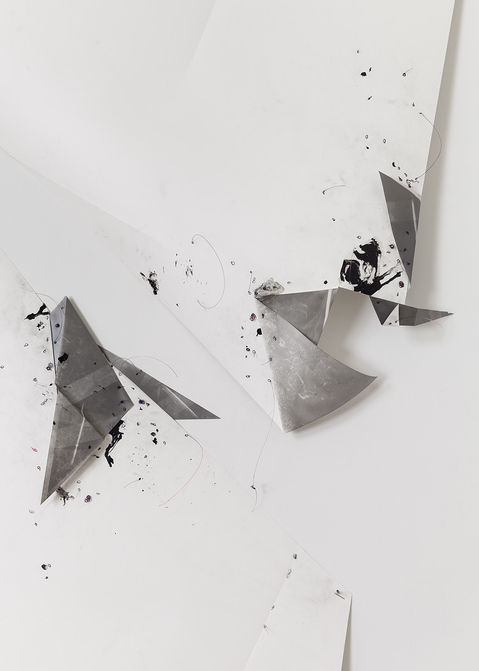
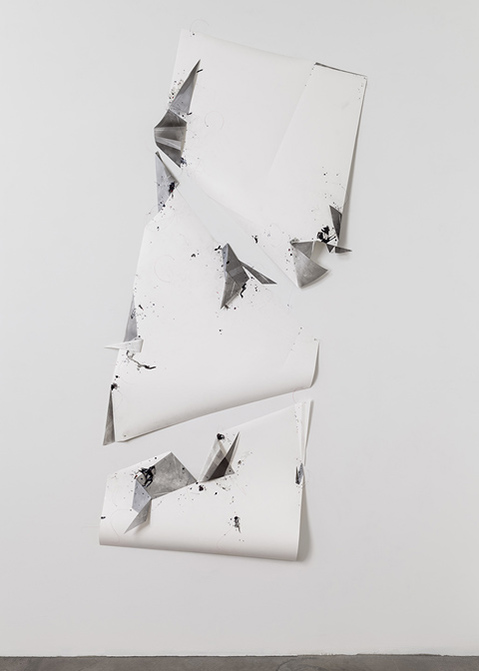
Top: Gelah Penn,
Photos by Etienne Frossard and courtesy Gelah Penn.
My love of film, and particularly film noir, informs both bodies of work. Installations are titled after movies, and the underlying abstract narrative in both is one of psychological dis-ease.
If drawing is about inquiry, which I firmly believe, then drawing in space seems an especially rich locus in which to pose a multitude of questions.
[portfolio_slideshow id=8353 exclude=”8385,8384,8377,8376,8362,8357″]
Gelah Penn’s work has been exhibited widely, including Lori Bookstein Fine Art, Smack Mellon, National Academy Museum, Sculpture Center, Jason McCoy Gallery (NYC); Carl Berg Projects (CA); Real Art Ways (CT); Rowan University Art Gallery (NJ); Clark University (MA); Brattleboro Museum (VT); and Bibliothèque Municipale Louis Nucéra (France). Her work is in the collections of the Columbus Museum (GA), Weatherspoon Art Museum (NC), Brooklyn Museum Library, (NY) and Cleveland Institute of Art/Gund Library (OH), and has been reviewed in numerous publications, including Art in America, The New York Times, The Brooklyn Rail and a feature in Sculpture Magazine. Penn has received fellowships from the Marie Walsh Sharpe Foundation, Yaddo and the MacDowell Colony. She has upcoming exhibitions at Foley Gallery and Lori Bookstein Fine Art. She is also co-curating, with artist Inna Babaeva, the exhibition object’hood at Lesley Heller Workspace, and, with painter and writer Stephen Maine, the exhibition Diphthong at the Shirley Fiterman Art Center in 2015.
Watch an interview with Gelah Penn on Gorky’s Granddaughter here.
View more of Gelah Penn’s work at her website, www.gelahpenn.com.
Subscribe to Tilted Arc
If you like this story, please consider subscribing. We are sticklers for privacy.
We will never sell or share your e-mail address.

